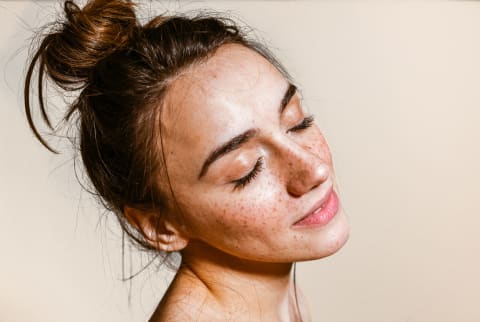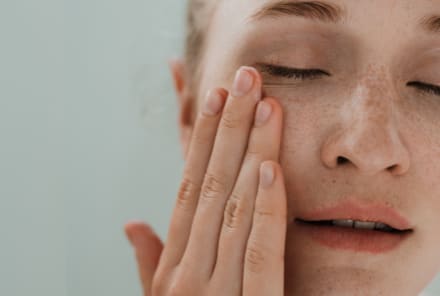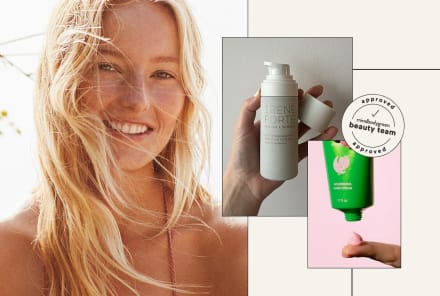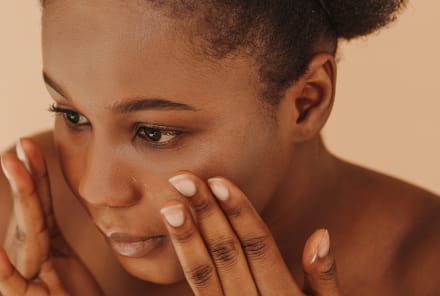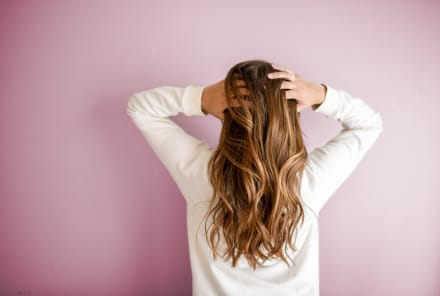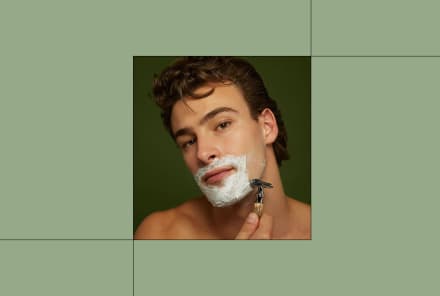Advertisement
Dark Spots, Melasma & Freckles: Our Breakdown On The Differences

As we inch closer to the glory days of summer, we also inch closer to sun damage. And when we think of sun damage, perhaps our first thoughts go to sunburn, with its signature tight, itchy, painful residual effects. But there are so many other types of damage that come about from unprotected and prolonged exposure: premature aging, dryness, and discoloration. The last of which comes in several forms. Sun-induced hyperpigmentation can come in the form of melasma, dark spots (also called age or sun spots), and an increase in freckles. And each is just so slightly different.
Before we begin: The best thing you can do to avoid sun damage is to be proactive with sun care. This means applying an adequate amount of SPF daily, choosing a UVA and UVB protection formula (like those with both zinc oxide and titanium dioxide), reapplying as needed, and making sure you don't skip any section, from your scalp to your toes.
Now that SPF is out of the way—just kidding! we talk about it again several times later—let's dive into these forms of hyperpigmentation.
Dark spots
"Dark spots" is a broad term that can include forms of hyperpigmentation like sun spots, age spots, and acne scars. "Hyperpigmentation is excess melanin production in your skin," says cosmetic dermatologist and founder of Epione Simon Ourian, M.D. When the skin faces any inflammation (brought on by sun exposure, blemishes, and even chronic low-grade inflammation over time), the cells that control melanin production—called melanocytes—can become overactive, leading to that extra pigment.
What dark spots look like:
They tend to be smaller, individualized patches of color. They can appear anywhere on the face or body and might be more concentrated in areas where you've recently had damage or inflammation. For example, if you break out on your cheeks, you'll likely have more dark spots there due to post-inflammatory hyperpigmentation—which may then worsen during the summer due to sun exposure. Or if you regularly forget to apply sunscreen on your shoulders, you may develop some there over time. They may also vary in severity: Some have light stains of pigment, while others may experience more dramatic tonal differences.
How to treat dark spots:
- Always apply sun protection (here's a good list of mineral options).
- Dark spot patches can help speed up the healing process.
- Vitamin C and nicotinamide offer brightening benefits.
- Gentle chemical exfoliators like lactic or glycolic acid can help slough off the surface-level pigment—but should be used in moderation, so you don't overexfoliate and cause additional damage.
Melasma
This type of hyperpigmentation is triggered by hormonal changes in the body (however, sun certainly doesn't help). "It isn't painful and doesn't present any health risks but can cause significant emotional distress for the estimated 6 million American women who develop these dark patches on their faces," says board-certified dermatologist Keira Barr, M.D. "Because it can be difficult to treat, minimizing triggers is important."
What melasma looks like:
This form of hyperpigmentation tends to show up in more localized areas on the face, such as the forehead, nose, cheeks, and the upper lip (sometimes called the melasma mustache)—and is less common on the body. These tend to form clusters together—and can appear quite large. Since these are triggered by hormonal changes, you may experience it when making birth control adjustments, are pregnant, or are going through menopause. Melasma, too, is also much more common in women—while the other forms of pigmentation can be experienced by anyone.
How to treat melasma:
- Since these are hormonal, you may want to visit a medical practitioner who can guide you on the right choices to make regarding balancing your hormones.
- As they can worsen due to the sun, protect the skin with SPF.
- Use gentle brightening ingredients, like azelaic acid and arbutin.
Freckles
Freckles are nothing to be ashamed of if you have them—but it's worth understanding their nuances in relation to sun exposure. They are actually a very specific type of sun spot but have a more complicated nature. See, the tendency to freckle is genetic, says board-certified dermatologist Loretta Ciraldo, M.D., FAAD. While all freckles come from sun exposure, they only appear "in people with the hereditary ability to form freckles," she says. According to a study published in the British Journal of Dermatology, only participants with a genetic predisposition to freckling were able to produce freckles when exposing their skin to high amounts of UV. In other words: Both fair- and darker-skinned individuals can freckle—it depends on your genetics, not necessarily your skin tone.
Additionally, freckles can be further separated into two types: ephelides and solar lentigines. While both ephelides and lentigines are affected by sunlight, ephelides are more predominantly genetically determined and tend to appear during early childhood, whereas lentigines are only induced by photodamage.
What freckles look like:
Freckles can appear anywhere on the face or body that has exposure to sunlight. They can vary depending on how prone to them you are—some may naturally develop an entire face of freckles, while others may get only a handful on their nose after a full summer of sun. (Of course, this depends on what type of freckles you have.) They are also usually small in diameter, while dark spots and melasma patches can grow larger.
How to treat freckles:
- If you have freckles naturally from childhood, embrace them! Nowadays people go out of their way to fake freckles via makeup.
- But since freckles form or worsen from sun exposure, you'll want to make sure you're using a proper SPF every day. If you naturally are prone to freckling, take it as a cue to be extra diligent.
- Be sure to incorporate antioxidants into your skin care routine to help neutralize free-radical and sun damage.
The takeaway.
Glowing skin is always in—but sun damage? Certainly not. It can come in many forms, each unique in and of itself, so worth explaining the differences. Once you know the differences, you can better treat them.
Watch Next
Enjoy some of our favorite clips from classes
Enjoy some of our favorite clips from classes
What Is Meditation?
Mindfulness/Spirituality | Light Watkins
Box Breathing
Mindfulness/Spirituality | Gwen Dittmar
What Breathwork Can Address
Mindfulness/Spirituality | Gwen Dittmar
The 8 Limbs of Yoga - What is Asana?
Yoga | Caley Alyssa
Two Standing Postures to Open Up Tight Hips
Yoga | Caley Alyssa
How Plants Can Optimize Athletic Performance
Nutrition | Rich Roll
What to Eat Before a Workout
Nutrition | Rich Roll
How Ayurveda Helps Us Navigate Modern Life
Nutrition | Sahara Rose
Messages About Love & Relationships
Love & Relationships | Esther Perel
Love Languages
Love & Relationships | Esther Perel
